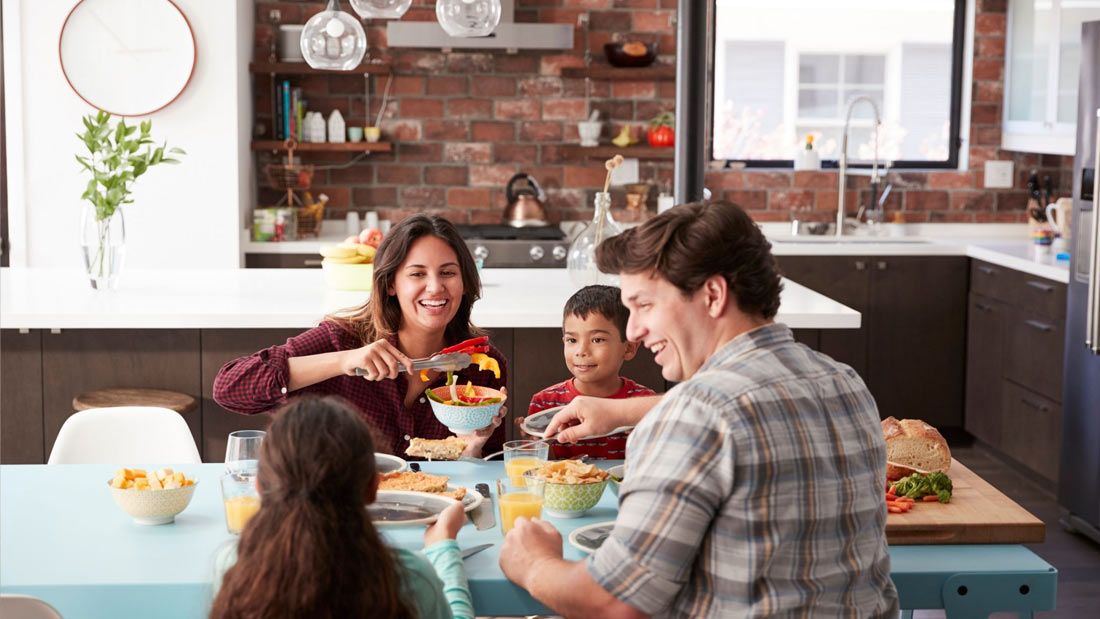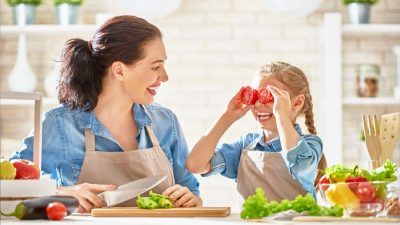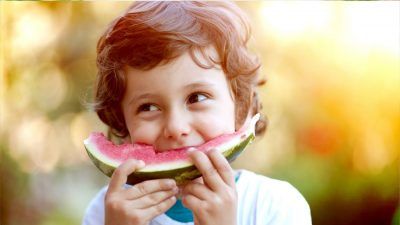How to make healthy vegan meals and snacks for kids

It’s easy for kids to fill up but that could mean they eat nothing but crisps and chocolate. It’s our job as parents and carers to make sure they are not just full but well-fed. Once you get used to the healthy meal routine, it’ll be a piece of cake – both for you and your child!
Below, you’ll find the basic food groups that make up a healthy vegan diet, a template for how to prepare nutritious meals and tips on how to increase the nutrient value of meals. For detailed information about each nutrient, please see the Nutrients section.
1. Fruit and vegetables
Children need them because:
Fruit and vegetables are the perfect source of healthy carbohydrates (healthy energy!), fibre, antioxidants, flavonoids (health-protecting nutrients), minerals (such as iron, calcium, magnesium, potassium), vitamins C, K and most of the B group.
They provide healthy energy and nutrients vital to growth, strong immune system and good digestion. Children should eat at least five portions a day.
The best choices:
- Fresh fruit – whole, cut in slices or cubes, blended in a smoothie or puréed
- Dried unsweetened fruit (apricots, figs, prunes) – whole for older children, blended in smoothies or purées for younger ones to avoid choking hazard
- Fresh vegetables – with meals, as a salad or blended in a smoothie
- Steamed, cooked or baked veggies – do not overcook them so they keep most of their nutrients
- Starchy vegetables – sweet potatoes, potatoes, pumpkins, squashes, root vegetables, sweetcorn. Potatoes are great sources of energy but they don’t count as one of the five-a-day portions because they don’t have as many nutrients as other veggies
- At least one serving of dark green leafy vegetable daily – kale, broccoli, rocket, watercress, Brussel’s sprouts, bok choy, collard/spring/mustard greens, etc – they are health-protective, good sources of minerals, such as calcium, and vitamins
If fresh fruit and vegetables are too expensive, head over to the freezer section – frozen fruit and veg are as nutritious as fresh ones.
Avoid tinned fruit and vegetables, pasteurised juices made from concentrate (it’s on the label) and sweetened or candied dried fruit because all of them offer mostly just sugar. The only exception is tinned sweetcorn which can be a part of a healthy diet.
2. Grains and wholegrains
Children need them because:
Wholegrains and cereal products are an amazing source of healthy carbohydrates, vitamins and minerals, even protein (wholegrains in particular).
They are an essential source of energy for the brain and body growth and keep the digestive system healthy.
Toddlers and small children need a mix of wholegrains (wholemeal) and refined (white) grain products to increase their energy intake. Giving them only wholegrains that are rich in fibre might make them full before they’ve eaten enough, so it’s best to mix it up. The older children get, the more wholegrains they should eat.
The best choices:
- No or low-sugar breakfast cereals or cereal mash
- Porridge
- Wholemeal, wholegrain or whole wheat products – bread, pasta, noodles, tortillas
- Rice – white, brown, red, wild
- Other wholegrains – quinoa, buckwheat, barley, millet, spelt, oats
- Oat-based products – muesli, granola, oat energy bars, oat cakes etc.
- Wholegrain crispbreads and crackers
- Wholemeal or oat biscuits – these can be very sugary so ration them
Avoid sugar-frosted breakfast cereals, sugar and fat-filled cereal products advertised as healthy, such as some snack bars, and white flour, sugar-laden biscuits.
3. Pulses
Children need them because:
Pulses are great sources of protein, healthy carbohydrates, fibre, B group vitamins, many minerals (including iron, zinc and calcium), antioxidants and flavonoids.
They are the main source of protein in a vegan diet, needed for growth and repair of all tissues in the body, and they also provide healthy energy.
The best choices:
- Lentils, beans, chickpeas – cooked from dried, out of a tin or roasted
- Products made from or with these – burgers, patties, dips, spreads, purées, soups, stews, curries, salads, hummus, falafel, lentil or bean pasta
- Soya and products made from it – edamame, tofu, tempeh, miso, mock meats, soya milk and yoghurts
- Peas – fresh or cooked, mushy, blended in a soup, roasted as a snack
Avoid undercooked beans, chickpeas and lentils – if they aren’t well cooked, they can make your child (and you) sick and you won’t be able to digest them properly.
4. Nuts and seeds
Children need them because:
Nuts and seeds are great sources of protein, healthy fats (apart from coconut), fibre, antioxidants, minerals including zinc and selenium, vitamin E and B group vitamins.
They are an excellent nutrition booster, provide energy and help top up children’s calorie intake.
The best choices:
- Nuts and seeds, preferably unsalted – for older children (so there’s no choking hazard)
- Nut butters and tahini (sesame seed paste/butter) – suitable from weaning onwards, used as a spread, stirred into soups and sauces, or blended in smoothies and purées
- All nuts are great but aim for a regular intake of almonds for calcium, cashews for iron, walnuts for omega-3 fats and Brazil nuts for selenium
- Seeds – pumpkin seeds are great for zinc, sesame seeds for calcium, ground flaxseed, shelled hempseed and chia seeds for omega-3 fats
Avoid giving your child salted nuts as they always contain too much salt and don’t rely on peanut butter too much – it can be a healthy part of any diet but children need other nuts and seeds too.
5. Supplements
Even though there’s been a lot of debate, all experts now agree that it is absolutely necessary to give vitamin D and vitamin B12 supplements to vegan children of all ages. (In fact, due to lack of sunlight in the UK, all children no matter what their diet, should have a vitamin D supplement.) You can find more information on these on the Supplements page.
Children also need a good source of iodine which is found mainly in seaweed. Things are a little tricky with iodine – it’s easy to get too little or too much of it so it may best to use a kelp supplement (it has a safe dose) a couple of times a week. If you live in a country where iodised salt is the norm, you likely don’t need to use supplements.
When it comes to minerals, such as iron, zinc, calcium and magnesium, children who eat enough in general and have plenty of the foods from all the basic food groups (above) daily, should be automatically getting enough of all these minerals. If you also choose calcium-fortified plant drinks, your child will be well-nourished.
Even though the healthy vegan diet rules are quite simple, sometimes there’s nothing more difficult than trying to get your child to eat certain foods. It’s not just frustrating, it also makes us worried that the said child will be missing out on important nutrients. If your child is a picky eater or simply doesn’t eat enough, you may want to give them a multivitamin/mineral supplement and they may also need an omega-3 fat supplement. Find more information about supplements for children in the Supplements section.
There are also several clever tricks for how to increase nutritional value of your child’s meals below – check them out! Your child may not want to eat tofu but that doesn’t mean that’s the end of the tofu road!

Although preparing healthy vegan meals that kids will love might sound like a challenge, it’s easier than you think! Just follow the simple template below – that way you’ll include all the basic food groups and the meals will be balanced.
Each healthy vegan meal should consist of:
Grains/Wholegrains (cereal products) or Root Veg
+
Pulses or Nuts/Seeds (or both)
+
Fruit or Veg
Here’s why:
- Grains/Wholegrains (cereal products) and Root Vegetables are great sources of healthy carbohydrates, some vitamins and minerals – the best choices are wholegrains (wholemeal bread, whole wheat pasta, brown rice, oats, quinoa), other grain products (morning cereals, regular pasta, rice, baked goods), potatoes, sweet potatoes and other root vegetables. Wholegrains are also good sources of protein.
- Pulses and Nuts/Seeds are excellent sources of protein, healthy fats, some vitamins and minerals – the best choices are lentils, beans, bean burgers, soya/edamame, soya burgers, tofu and tofu sausages, tempeh, chickpeas, hummus, falafel, nuts and seeds (and butters made from them).
- Fruit and Vegetables are fantastic sources of healthy carbohydrates, vitamins, minerals and antioxidants – the best choices are fresh fruit and vegetables, dried unsweetened fruit, lightly cooked vegetables
For more details on each nutrient, please head over to the Nutrients section.
If you’re packing a lunchbox for your child, it’s good to follow the template outlined above. That means that each lunchbox should have some cereal product (preferably wholegrain) or root vegetables (potatoes or sweet potatoes), pulses or nuts/seeds (or both) and some fruit or veggies.
Of course, packing potatoes in a lunchbox is not very practical, so most of the time, you’ll probably be packing bread, pasta, rice, corn or oat cakes, wraps, pies, or muffins. Sandwiches or wraps are popular options, especially because you can easily stuff them with the other meal ingredients – pulses (hummus, falafel, bean spread, tofu or mock meat slices, tempeh) or nut butters and sliced veggies. Here are some ideas:
- Sandwich with hummus or bean spread and veggies
- Wrap with avocado, beans, peppers and salsa
- Peanut butter and jam sandwich with fruit on the side
- Sandwich with smoked tofu/tempeh/mock meat slices and veggies
- Sandwich with vegan cream cheese and veggies with some nuts and seeds on the side
- Pie or quiche with tofu, leeks and tomatoes, or with lentil/chickpea curry
- Chickpea omelette with veggies
- Savoury muffins with seeds and veggie sticks on the side
- Falafel wrap with fresh veggies
- Pasta salad with vegetables and beans or cut-up tofu sausages
- Sushi wrap with tofu and veggie sticks
- Salad with nuts and beans, bread on the side
- Rice balls with peas, vegetables on the side
- Lentil or bean patties in a bun with veggies
- Vegan cheese toastie with cherry tomatoes and cashews on the side
- Puff pastry parcels with lentil and veggies stuffing
- Bean salad with corn, bread on the side
For some of the above recipes and more, including serving suggestions, see Vegan Recipe Club page on Kids’ Lunchbox Ideas.
Usually, you’ll also be packing some snacks for your child – read on!

Children need snacks to meet their nutrient requirements and also because their tummies are small so can’t hold a lot of food – they have to eat more often.
Children get the best nutrition if their snacks follow the structure of main meals, just on a smaller scale. Here are some examples of how that might look:
- Oat cakes with nut butter and fruit
- Energy balls or bars made from nuts, oats and dried fruit and a fresh smoothie
- Rice cakes with tahini (sesame seed paste) and fruit slices
- Plant yoghurt with oats and fruit
- Smoothie with nuts and oats blended in
- Plant-milk cocoa, oat biscuits and fruit
- Toast with hummus and veggie sticks
- Toast with nut butter and sliced fruit
- Sandwich with vegan cheese and veggies, or use bean spread or nut butter
- Sandwich with avocado, tomato slices and seeds
- Bean or lentil salad – or soup – and a slice of bread
- Nori (seaweed) sheets stuffed with rice, tofu and veggies – folded into triangles, squares or rolls
- Tortilla wraps with plant-based spread, beans and veggies
- Home-made traybake or muffin-style creations made with wholemeal flour, nuts and fruit can also be a great snack
Here are some kid-friendly sandwich options from our Vegan Recipe Club!
Children have small tummies and many are picky eaters but luckily, there are tricks for how to cram as many nutrients as possible into their meals.
- Sprinkle nuts and seeds on top of meals
- Blend tofu, beans, chickpeas or lentils into sauces and soups
- Add oats, seeds, nuts or nut butters into smoothies
- Make fresh smoothies to increase your child’s fruit intake
- Blend vegetables they may not otherwise eat into creamy soups
- Use chickpea flour instead of a part of wheat flour when baking, or for pancakes to increase protein content
- Add nutritional yeast to savoury meals – it adds a good dose of B vitamins and some protein too
- Add wheat germ to cereals and sweet meals – it contributes a good dose of B vitamins and some minerals, such as iron, zinc and magnesium
- Add tahini to savoury meals – stir it in or drizzle on top
- Make tofu banana fool, chocolate mousse, or use it in ‘cheesecakes’ to top up your child’s protein intake
- Make flapjack-style oat snack bars with added seeds, dates and topped with walnuts
- Add healthy fats to their meals – avocado, extra virgin olive oil, rapeseed oil when cooking, plant-based cream
When children are at home with you, you have greater control over what they eat but when it comes to school, kids’ parties and know-it-all grandparents, things get tricky. Our children are always scrutinised, their diet questioned and people may try to tempt them to eat what you’d never give them. How to approach these situations?
Communicate
Communication is key. Talk to your child about why you are vegan and that others may try to give them non-vegan food. Don’t accuse anyone of being one-way or another, that would be unhelpful, just explain that those people might eventually change their mind, too. Try to focus on all the positive aspects of your lifestyle and encourage your child to offer their food to others if they ask about it. Children tend to mock what’s different but they are also curious, so all it takes is one child willing to try what your kid is having to shift the balance.
Another important aspect is to highlight that vegan food is normal food – bread, pasta, rice, fruit, baked beans, peanut butter, etc. Your child (and others around them) should be aware that what they are eating is essentially the same as what others eat, just without the animal ingredients. Sometimes, talking about being vegan may bring about the image that everything vegans eat is somehow different and special. It’s good to bring the discussion back to basics and highlight that we eat normal foods with just a few extra tweaks.
Compromise on small things
On special occasions, such as birthday parties, try to find compromises for your child – maybe you don’t want to give them sugar or crisps on a daily basis but you can make an exception. Be proactive and bring treats that are vegan so you know that your child will be able to have some – fruit jellies, biscuits, chocolate-covered raisins, chocolate buttons, vegan marshmallows, potato crisps, chickpea puffs, mixed nuts, popcorn, vegan sausage roll, etc. If you bake, make a vegan cake or tray-bake for everyone to share.
If you’d like to show others that vegan food is both healthy and delicious, make some healthier options – fruit skewers dipped in chocolate, oat and nut biscuits, kidney bean brownies, wholemeal carrot cake muffins, Banana bread or this Chocolate berry cake.
Set boundaries
Explain to the adults you’re leaving your child with that they are not to give your child non-vegan food. If the fact that it’s against your beliefs isn’t enough, highlight that it causes your child tummy troubles since they are not used to animal products. If they don’t respect that, try to have another conversation with them but if that becomes impossible, explain that you cannot leave your child with someone you cannot trust. When your child gets older, they will be able to set their own boundaries but until that time, it’s up to you to help them.
Some families eventually find common ground, while others may be divided – there’s no sugar-coating the fact that veganism causes friction in families. However, keep trying to win your family over with foods, leading by example, mentioning good initiatives and moves by others (such as a doctor recommending vegan food, a scientific report warning against animal products consumption, or even celebrities going vegan). That’s not to say you should bombard them with things but better be prepared with some good food and good examples than to be scrambling for arguments when confronted! The good news is, there’s a growing number of plant-based health professionals so you may find support in unexpected places.







